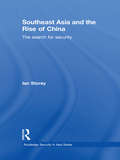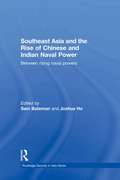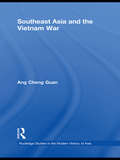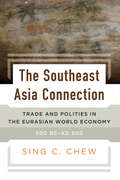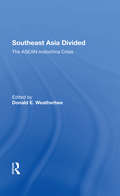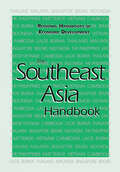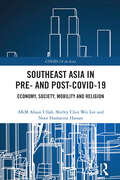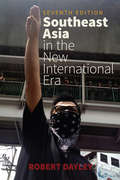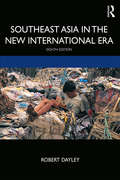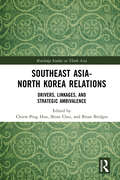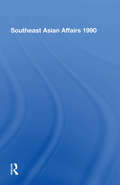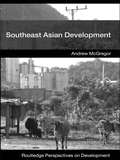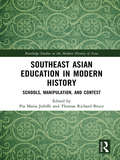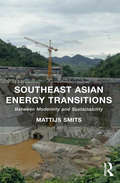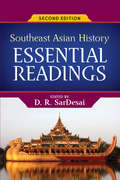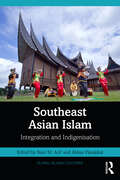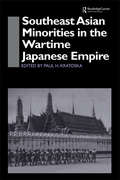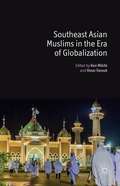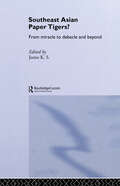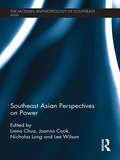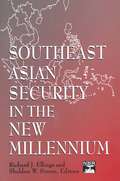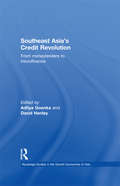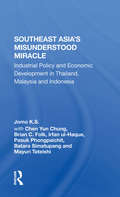- Table View
- List View
Southeast Asia and the Rise of China: The Search for Security (Routledge Security in Asia Series)
by Ian StoreySince the early 1990s and the end of the Cold War, the implications of China's rising power have come to dominate the security agenda of the Asia-Pacific region. This book is the first to comprehensively chart the development of Southeast Asia’s relations with the People’s Republic of China (PRC) from 1949 to 2010, detailing each of the eleven countries’ ties to the PRC and showing how strategic concerns associated with China's regional posture have been a significant factor in shaping their foreign and defence policies. In addition to assessing bilateral ties, the book also examines the institutionalization of relations between the Association of Southeast Asian Nations (ASEAN) and China. The first part of the book covers the period 1949-2010: it examines Southeast Asian responses to the PRC in the context of the ideological and geopolitical rivalry of the Cold War; Southeast Asian countries’ policies towards the PRC in first decade of the post-Cold War era; and deepening ties between the ASEAN states and the PRC in the first decade of the twenty-first century. Part Two analyses the evolving relationships between the countries of mainland Southeast Asia - Vietnam, Thailand, Myanmar, Laos and Cambodia - and China. Part Three reviews ties between the states of maritime Southeast Asia - Indonesia, Malaysia, Singapore, the Philippines, Brunei and East Timor - and the PRC. Whilst the primary focus of the book is the security dimension of Southeast Asia-China relations, it also takes full account of political relations and the burgeoning economic ties between the two sides. This book is a timely contribution to the literature on the fast changing geopolitics of the Asia-Pacific region.
Southeast Asia and the Rise of Chinese and Indian Naval Power: Between Rising Naval Powers (Routledge Security in Asia Pacific Series)
by Sam Bateman Joshua HoThis book examines the emerging maritime security scene in Southeast Asia. It considers highly topical implications for the region of possible strategic competition between China and India - the rising naval powers of Asia - with a possible naval "arms race" emerging between these countries both with naval force development and operations. As part of its "Look East" policy, India has deployed naval units to the Pacific Ocean for port visits and exercises both with East Asian navies and the US Navy, but India is also concerned about the possibility of the Chinese Navy operating in the Indian Ocean. Even as the US-India defence relationship continues to deepen, the US and China are struggling to build a closer links. China’s and India’s strategic interests overlap in this region both in maritime strategic competition or conflict – which might be played out in the Bay of Bengal, the Malacca and Singapore Straits and the South China Sea. The sea lines of communication (SLOCs) through Southeast Asian waters constitute vital "choke points" between the Indian and Pacific Oceans carrying essential energy supplies for China and other Northeast Asian countries. Any strategic competition between China and India has implications for other major maritime players in the Pacific and Indian Oceans, especially Australia, the Republic of Korea and Japan, as well as the US. This book identifies possible cooperative and confidence-building measures that may contribute to enhanced relations between these two major powers and dampen down the risks associated with their strategic competition.
Southeast Asia and the Vietnam War (Routledge Studies in the Modern History of Asia)
by Cheng Guan AngThis book describes and explains Indonesia, Malaysia and Singapore’s attitudes and policies regarding the Vietnam War. While it is generally known that all three countries supported the US war effort in Vietnam, it reveals the motivations behind the decisions of the decision makers, the twists and turns and the nuances in the attitudes of Jakarta, Kuala Lumpur and Singapore following the development of the war from the 1950s through to its end in 1975. Although the principal focus is the three supposedly non-aligned countries - Indonesia, Malaysia and Singapore, the perspectives of Thailand and the Philippines - the two Southeast Asian countries which were formally allied with the United States - are discussed at the appropriate junctures. It makes an original contribution to the gradually growing literature on the international history of the Vietnam War and furthers our knowledge of the diplomatic history of Indonesia, Malaysia and Singapore in the early independent years, 1945/1949, 1957 and 1965 respectively, which coincided with early years of the Cold War in Southeast Asia.
The Southeast Asia Connection: Trade and Polities in the Eurasian World Economy, 500 BC–AD 500
by Sing C. ChewThe contribution of Southeast Asia to the world economy (during the late prehistoric and early historic periods) has not received much attention. It has often been viewed as a region of peripheral entrepôts, especially in the early centuries of the current era. Recent archaeological evidence revealed the existence of established and productive polities in Southeast Asia in the early parts of the historic period and earlier. This book recalibrates these interactions of Southeast Asia with other parts of the world economy, and gives the region its due instead of treating it as little more than of marginal interest.
The Southeast Asia Connection: Trade and Polities in the Eurasian World Economy, 500 BC–AD 500
by Sing C. ChewThe contribution of Southeast Asia to the world economy (during the late prehistoric and early historic periods) has not received much attention. It has often been viewed as a region of peripheral entrepôts, especially in the early centuries of the current era. Recent archaeological evidence revealed the existence of established and productive polities in Southeast Asia in the early parts of the historic period and earlier. This book recalibrates these interactions of Southeast Asia with other parts of the world economy, and gives the region its due instead of treating it as little more than of marginal interest.
Southeast Asia Divided: The Asean-indochina Crisis
by Donald E WeatherbeeThe central problem of international politics in Southeast Asia since December 1978 has been the Vietnamese armed presence in Kampuchea. The noncommunist nations of the Association of Southeast Asian Nations (ASEAN) have insisted that Vietnam withdraw from Kampuchea; the Vietnamese, perceiving a threat from the PRC and an ASEAN-sponsored Khmer resistance, maintain that the situation is irreversible. The contributors discuss the conflict from the point of view of all parties involved (ASEAN, Vietnam, the PRC, the USSR, and the U.S.) and assess various strategies for its resolution.
The Southeast Asia Handbook (Regional Handbooks of Economic Development #Vol. 3)
by Greg Bankoff Michael Haas Patrick Heenan Monique LamontagneThe Regional Handbooks of Economic Development series provides accessible overviews of countries within their larger domestic and international contexts, focusing on the relations among regions as they meet the challenges of the twenty first century.The series allows the non-specialist student to explore a wide range of complex factors-social and political as well as economic-that affect the growth of developing regions in Asia, Europe, and South America. Each Handbook provides an overview chapter discussing the region's economic conditions within an historical and political context, as well as 20 or more chapter-length essays written by recognized experts, which analyze the key issues affecting a region's economy: its population, natural resources, foreign trade, labor problems, and economic inequalities, and other vital factors.In addition, the volumes offer useful support materials, including a series of appendices that include a detailed chronology of events in the region, a glossary of terms, biographical entries on key personalities, an annotated bibliography of further reading, and a comprehensive analytical index.
Southeast Asia in Pre- and Post-COVID-19: Economy, Society, Mobility and Religion (COVID-19 in Asia)
by Noor Hasharina Hassan AKM Ahsan Ullah Shirley Chin LeeUllah, Chin, and Hassan provide a comprehensive examination of the transformative impact of the COVID-19 pandemic on Southeast Asia, examining its effects on the region’s economy, social dynamics, mobility patterns and religious practices.The book examines the profound changes and challenges that the region faced, offering insights into both the immediate responses and the long-term adjustments in these key aspects of Southeast Asian life. An in-depth analysis with a comprehensive and up-to-date perspective on the region’s postpandemic landscape offers informed insights into the diverse challenges and opportunities facing Southeast Asia in a rapidly changing world.This book is an essential reading for academics, researchers and policymakers seeking to gain a nuanced understanding of Southeast Asia’s response to the pandemic COVID-19.
Southeast Asia in the New International Era
by Robert DayleySoutheast Asia in the New International Era, seventh edition, provides readers with up-to-date coverage on a vibrant region home to more than 600 million people, vast cultural diversity, and dynamic globalized markets. Sensitive to historical legacies, and with special attention to developments since the end of the Cold War, this book highlights the events, players, and institutions that shape the region. Employing a country-by-country format, the analysis engages in context-specific treatment of the region's eleven countries: Thailand, Myanmar (Burma), Vietnam, Cambodia, Laos, the Philippines, Indonesia, Timor-Leste, Malaysia, Singapore, and Brunei. Each chapter focuses on political and economic developments, key institutions, state-society relations, and foreign affairs. In light of the December 2015 launch of the new ASEAN Community, this seventh edition includes a new chapter on ASEAN and the prospects of regional integration. An excellent resource for students, Southeast Asia in the New International Era makes sense of the region's coups, policy debates, protests, and alliances, leaving readers with a solid foundation for further study.
Southeast Asia in the New International Era
by Robert DayleyThis newly revised eighth edition of Southeast Asia in the New International Era provides readers with contemporary coverage of a vibrant region home to more than 650 million people, vast cultural diversity, and dynamic globalized markets. Sensitive to historical legacies and paying special attention to developments since the end of the Cold War, this book highlights the events, players, and institutions that shape the region. Employing a country-by-country format, the analysis engages in context-specific treatment of the region's eleven countries: Thailand, Myanmar (Burma), Vietnam, Cambodia, Laos, the Philippines, Indonesia, Timor-Leste, Malaysia, Singapore, and Brunei. Fully updated, the book’s revised content includes Rodrigo Duterte’s drug war in the Philippines, Malaysia’s historic 2018 election ending four decades of UMNO rule, Hun Sen’s latest power grab in Cambodia, and a consequential monarchical transition in post-coup Thailand. It also analyzes recent developments in the South China Sea dispute, the Rohingya tragedy in Myanmar, China’s expanding Belt and Road Initiative, as well as the effects of the Trump Administration’s tariffs and trade war. An excellent resource for students, this textbook makes sense of the region's coups, elections, policy debates, protests, and alliances, leaving readers with a solid foundation for further study.
Southeast Asia in the New International Era
by Robert DayleyThis newly revised and updated ninth edition of Southeast Asia in the New International Era provides readers with contemporary coverage of a vibrant region home to more than 675 million people.Sensitive to historical legacies and paying special attention to developments since the end of the Cold War, this book highlights the events, players, and institutions that shape the region politically and economically. The scope of analysis provides context-specific treatment of the region’s 11 countries: Thailand, Myanmar (Burma), Vietnam, Cambodia, Laos, Philippines, Indonesia, Timor-Leste, Malaysia, Singapore, and Brunei. Three thematic chapters consider broader regional issues: Southeast Asia Political Economy, ASEAN, and South China Sea. Fully updated, the book’s revised content includes new discussion of the effects of the Covid-19 pandemic, Myanmar’s 2021 military coup, the return of the Marcos clan in the Philippines, political dynasty in Cambodia, youth demonstrations calling for monarchy reform in Thailand, Malaysia’s 2022 elections, and the relocation of Indonesia’s capital from sinking Jakarta to Borneo. New to this edition is a dedicated chapter explaining the territorial disputes in the South China Sea.An excellent resource for students and professionals seeking to understand Southeast Asia, this book helps make sense of the region’s political complexity while building a solid foundation for further study.
Southeast Asia-North Korea Relations: Drivers, Linkages, and Strategic Ambivalence (Routledge Studies on Think Asia)
by Chiew-Ping HooSoutheast Asia-North Korea Relations reveals the genesis and evolution of Southeast Asian countries’ diplomatic relations with the Democratic People’s Republic of Korea (DPRK/North Korea) by unpacking the underlying political, economic, and security connections.In this book, chapters analyse in detail the individual bilateral linkages of the ten states of the Association of Southeast Asian Nations (ASEAN) with the DPRK that vary in intensity and visibility. Bringing together an international group of experts, including, uniquely, authors representing every individual ASEAN state, this edited volume dissects the parameters of the bilateral relationships as well as the multi-faceted regional-level interactions and the roles of certain key external actors, especially South Korea and China.This book is a path-breaking addition to the study and analysis of regional inter-linkages in Asia and will be of interest to students and scholars working on North Korean studies, Southeast Asia, including ASEAN, and also on Korean Peninsula topics as well as international relations and security studies, especially considering the role of “small” states.
Southeast Asian Affairs 1990
by The Institute of Southeast Asian StudiesThis is an annual review of significant developments and trends in Southeast Asia, with particular emphasis on the ASEAN countries. Aimed at giving the reader a broad grasp of current regional affairs, this volume contains 21 articles dealing with such themes as international conflict and co-operation, political stability and economic growth and development.
Southeast Asian Development (Routledge Perspectives on Development)
by Andrew McGregorSoutheast Asia has long fascinated development practitioners and researchers for being one of the few regions of the world that has resisted global trends to become a successful developing region. Divided into accessible thematic chapters, this book adopts a unique perspective of equitable development to outline the strengths and weaknesses of the transformations taking place in the Southeast Asian region. Focusing on four key themes: equality and inequality; political freedom and opportunity; empowerment and participation; and environmental sustainability, these concepts are used to explore Southeast Asian development and trace the impacts that the growing popularity of market-led and grassroots approaches are having upon economic, political and social processes. Whilst the diversity of the region is emphasized so are some of the homogenizing trends such as the concentration of wealth and services in urban areas and the subsequent migration of rural people into urban factories and squatter settlements. The ongoing commercialization and industrialization of rural agriculture as well as the expansion of non-farm income earning opportunities in rural spaces, and the alarming rates of environmental degradation which threaten health and livelihoods are also exposed. In highlighting how Southeast Asian development is unevenly distributing wealth, opportunities and risks throughout the region, this book emphasizes the need for creative new approaches to ensure that benefits of development are equitably enjoyed by all. Including illustrations, case studies and further reading, this book provides an accessible up-to-date introductory text for students and researchers interested in Southeast Asian development, development studies, Asian studies and geography.
Southeast Asian Education in Modern History: Schools, Manipulation, and Contest (Routledge Studies in the Modern History of Asia)
by Pia Maria Jolliffe Thomas Richard BruceHow particular has Southeast Asia’s experience of educational development been, and has this led to an identifiably distinct Southeast Asian approach to the provision of education? Inquiry into these questions has significant consequences for our understanding of the current state of education in Southeast Asia and the challenges it has inherited. This book contributes to a better understanding of the experience of educational development in Southeast Asia by presenting a collection of micro-historical studies on the subject of education, policy and practice in the region from the emergence of modern education to the end of the twentieth century. The chapters fathom the extent to which contest over educational content in schools has occurred and establish the socio-cultural, political and economic bases upon which these contestations have taken place and the ways in which those forces have played out in the classrooms. In doing so, the book conveys a sense of the extent to which modern forms of education have been both facilitated and shaped by the region’s specific configurations; its unique demographic, religious, social, environmental, economic and political context. Conversely, they also provide examples of the sorts of obstacles that have prevented education making as full an impact on the region’s recent 'modern' transformation as might have been hoped or expected. This book will be of interest to academics in the field of Southeast Asian Studies, Asian Studies, education, nationalism, and history.
Southeast Asian Energy Transitions: Between Modernity and Sustainability
by Mattijs SmitsAddressing the apparent tensions between modernity and sustainability in Southeast Asia, this book offers novel insights into the global challenge of moving towards a low carbon energy system. With an original and accessible take on social theory related to energy transitions, modernity and sustainability, Mattijs Smits argues for a reinvigorated geography of energy. He also challenges universalistic and linear assumptions about energy transitions and makes the case for ’energy trajectories’, stressing embeddedness, contingency and connections between scales. Contemporary and historical empirical examples from Southeast Asia, primarily Thailand and Laos, are drawn upon to show the importance of scale at regional, national, local and household levels. The transitions in the national power sectors here have been intimately related to discourses of modernity and state formation since the colonial era. More recently, plans for international cooperation and discourses of regional power trade have taken centre stage. Local energy trajectories are understood to be part of these transitions, but also as embedded in local social, political and spatial relations. Examining how energy practices go hand-in-hand with the dissemination of different technologies, this work shows the complexities of achieving sustainability in the context of rapidly changing energy modernities in Southeast Asia.
Southeast Asian History: Essential Readings
by D.R. SarDesaiDesigned to stand on its own, or to accompany the seventh edition of D. R. SarDesai's Southeast Asia: Past and Present, this updated reader includes classic and recent works on the history of Southeast Asia. SarDesai has selected literary and historical writings that address crucial controversies in the region of Southeast Asia. The readings are organized in four sections (Cultural Heritage, Colonial Interlude, Nationalist Response, and the Fruits of Freedom) and cover the entire range of Southeast Asian history from ancient to contemporary times. Geographically, the book includes Myanmar, Thailand, Malaysia, Brunei, Singapore, Indonesia, East Timor, Laos, Cambodia, Vietnam, and the Philippines.The revised second edition retains the most popular readings from the first edition, while replacing some of the historical chapters, updating the contemporary and recent coverage, and adding new readings to pertinent subject areas. Southeast Asian History: Essential Readings provides valuable context and critical background to events of this region.
Southeast Asian Islam: Integration and Indigenisation (Global Islamic Cultures)
by Nasr M. Arif Abbas PanakkalThis book explores Muslim communities in Southeast Asia and the integration of Islamic culture with the diverse ethnic cultures of the region, offering a look at the practice of cultural and religious coexistence in various realms.The volume traces the origins and processes of adoption, transmission, and adaptation of Islam by diverse ethnic communities such as the Malay, Acehnese, Javanese, Sundanese, the Bugis, Batak, Betawi, and Madurese communities, among others. It examines the integration of Islam within local politics, cultural networks, law, rituals, education, art, and architecture, which engendered unique regional Muslim identities.Additionally, the book illuminates distinctive examples of cultural pluralism, cosmopolitanism, and syncretism that persisted in Islamic religious practices in the region owing to its maritime economy and reputation as a marketplace for goods, languages, cultures, and ideas.As part of the Global Islamic Cultures series that investigates integrated and indigenized Islam, this book will be of interest to students and researchers of theology and religion, Islamic studies, religious history, political Islam, cultural studies, and Southeast Asian studies. It also offers an engaging read for general audiences interested in world religions and cultures.
Southeast Asian Minorities in the Wartime Japanese Empire
by Edited by Paul H. KratoskaThe Japanese invasion and occupation of southeast Asia provided opportunities for the peoples of the region to pursue a wide range of agendas that had little to do with the larger issues which drove the conflict between Japan and the allies. This book explores how the occupation affected various minority groups in the region. It shows, for example, how in some areas of Burma the withdrawal of established authority led to widespread communal violence; how the Indian and Chinese populations of Malaya and Thailand had extensive and often unpleasant interactions with the Japanese; and how in Java the Chinese population fared much better.
Southeast Asian Muslims in the Era of Globalization
by Ken Miichi Omar FaroukThis volume investigates the appropriate position of Islam and opposing perceptions of Muslims in Southeast Asia. The contributors examine how Southeast Asian Muslims respond to globalization in their particular regional, national and local settings, and suggest global solutions for key local issues.
Southeast Asian Paper Tigers
by Jomo K. S.This important collection is a timely contribution to the debate on the Asian financial crisis. With chapters written by well-established international experts in Asian economics, this book constitutes a finely judged example of the varying opinions on the matter.
Southeast Asian Perspectives on Power (The Modern Anthropology of Southeast Asia)
by Joanna Cook Lee Wilson Nicholas Long Liana ChuaSoutheast Asia has undergone innumerable far-reaching changes and dramatic transformations over the last half-century. This book explores the concept of power in relation to these transformations, and examines its various social, cultural, religious, economic and political forms. The book works from the ground up, portraying Southeast Asians’ own perspectives, conceptualizations and experiences of power through empirically rich case studies. Exploring concepts of power in diverse settings, from the stratagems of Indonesian politicians and the aspirations of marginal Lao bureaucrats, to mass ‘Prayer Power’ rallies in the Philippines, self-cultivation practices of Thai Buddhists and relations with the dead in Singapore, the book lays out a new framework for the analysis of power in Southeast Asia in which orientations towards or away from certain models, practices and configurations of power take centre stage in analysis. In doing so the book demonstrates how power cannot be pinned down to a single definition, but is woven into Southeast Asian lives in complex, subtle, and often surprising ways. Integrating theoretical debates with empirical evidence drawn from the contributing authors’ own research, this book is of particular interest to scholars and students of Anthropology and Asian Studies.
Southeast Asian Security in the New Millennium (A\study Of The National Bureau Of Asian Research Ser.)
by Sheldon W. Simon Richard J. EllingsAssessing trends toward creating innovative forms of political, economic and security co-operation in Southeast Asia, this text discusses the international dynamics of Southeast Asian security, and its impact on such external factors as the US, China and Japan.
Southeast Asia's Credit Revolution: From Moneylenders to Microfinance (Routledge Studies in the Growth Economies of Asia)
by David Henley Aditya GoenkaSoutheast Asia’s Credit Revolution describes and explains the rise of microfinance – the provision of credit and other financial services for the poor – in Southeast Asia, over the past four decades the most consistently successful region of the developing world. In recent years microfinance has come to be seen as a key weapon in the battle against global poverty, generating more enthusiasm and optimism than any other development strategy. Southeast Asia has a special place in the history of microfinance. Historically, Southeast Asian societies and economies were perceived as almost uniquely debt-ridden and credit-constrained. In the twentieth century, however, the region was in the forefront of the modern microfinance revolution. This book asks what factors have made it possible for formal microfinance institutions to replace moneylenders and other traditional credit providers. Bringing together economists, sociologists, anthropologists and historians, the book covers seven Southeast Asian countries. The topic is explored from cultural and institutional as well as economic perspectives, and policy-relevant lessons are offered for the design of successful microfinance institutions. Focusing on recent developments while putting them in historical context, this will be an important text for scholars and students of economic history, finance, institutional economics, and Asian Studies.
Southeast Asia's Misunderstood Miracle: Industrial Policy And Economic Development In Thailand, Malaysia And Indonesia
by Jomo K.S."The debate on the major factors contributing to Southeast Asian industrialization continues unabated. As might be expected, there is much at stake in this debate. The debate is largely ideological in nature and partly centers on the role and contribution of state interventions and other institutions in market processes in the context of late industrialization. At the risk of caricaturing the debate, on the one hand, one finds the dominant and more influential position held by those who blame the state for all that has gone wrong and credit the market for all that has turned out right; on the other hand, the minority statist extreme position basically credits most major economic achievements in East Asia to appropriate interventions by developmentalist states. While very few people would actually fully identify with either of these caricatured extremes, much of the discussion actually gravitates around either of these poles. "
